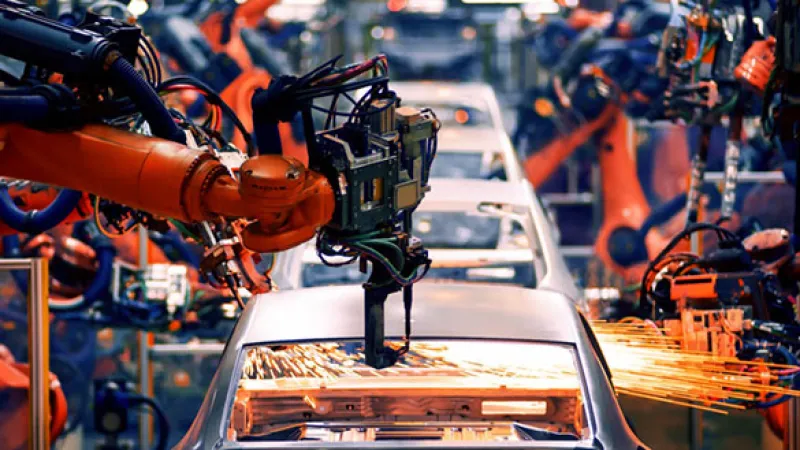By Blu Putnam and Erik Norland, CME Group
AT A GLANCE
- Rising inflation, the withdrawal of policy stimulus, and the potential for eroding corporate profit margins are three key stagflation risks to watch
- The swift pace of monetary and fiscal policy changes could lead to slower than expected economic activity with a six to 12-month lag
With prices rising and many uncertainties facing the U.S. economy, the risks of stagflation – that is, 1970s like elevated inflation with slow growth or even a recession – are rising. There are three key stagflation risks to examine:
- Inflation erodes purchasing power and can weaken the economy, while supply shocks are creating challenges in many sectors.
- The accommodative policies during the pandemic are being withdrawn.
- Many goods-producing companies are seeing profit squeezes from high input costs and rising worker compensation, potentially leading to production cutbacks or less investment.
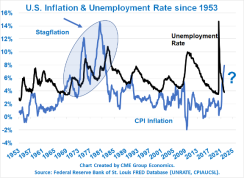
Rising Inflation Can Be a Drag
If consumer spending does not outpace inflation, then on net one is getting less goods and services, even while spending more money. Real GDP might shrink.Take gasoline prices at the pump. At $4/gallon, $100 buys 25 gallons. If the price rises to $5/gallon, one could spend more money, say $110, yet get only 22 gallons instead of 25. Real GDP is a quantity measure, so fewer gallons would be reflected in an erosion of real GDP.
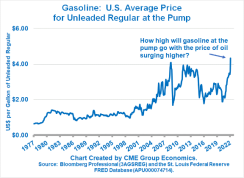
And then there are supply chain challenges that have resulted in constraining production of certain goods. For example, the computer chip shortage has resulted in lower production of new automobiles.
Both Fiscal and Monetary Policies are Withdrawing Stimulus
There was massive fiscal stimulus in 2020 and 2021 during the pandemic, and those stimulus payments have come to an end. In addition, various moratoriums on rent payments, evictions, utility cutoffs, student loans, etc., are also ending.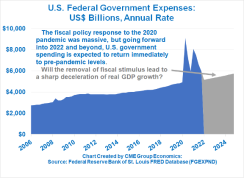
On the monetary policy side, the Federal Reserve is starting to raise short-term rates, and the likely shrinkage of the Fed’s balance sheet is contributing to pressure for higher yields in the bond market, raising home mortgage lending costs.
The net is that the U.S. economy had a powerful and swift rebound from the pandemic, but the policy stimulus that made that possible is ending. The economy would have slowed naturally from a rapid rebound, but the swift pace of policy change could lead to slower than expected economic activity with a six to twelve month lag.
Higher Input Costs
Corporate profit growth is at risk from rising producer prices and accelerating compensation costs.Many companies in the goods producing sector are likely to see profit growth erode with higher input costs, even if some sectors, such as energy, may do well.
Producer price inflation has surged to the 20% territory, growing more than twice as fast as consumer price inflation. If you are watching corporate profits, monitoring developments in producer prices may be much more important than overall inflation.
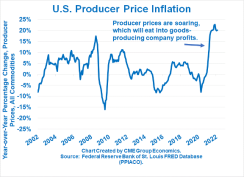
And the labor market is tight, too. The U.S. is seeing rising compensation costs for all employees, not just hourly workers. Total compensation costs are still growing less than consumer price inflation; however, many analysts expect labor cost pressures to only accelerate in this environment.
The conclusion is that the share of corporate profits in nominal GDP is likely to decline from the current elevated level. It is an open question as to whether equity markets have fully discounted both eroding profits and a rising hurdle rate (that is, bond yields), but slowing industrial production could be a drag on real GDP growth.
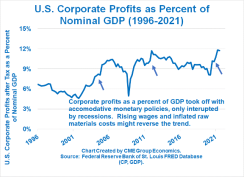
The bottom line is that rising inflation, withdrawal of policy stimulus, and potential for eroding corporate profit margins all add to the risks of stagflation – that is, high inflation with little economic growth. The stagflation potential puts tremendous pressure on the Federal Reserve. No one wants a recession, and no one wants long-term, persistent inflation. Can the Fed negotiate a soft-landing for the economy in the face of these powerful risks? Only time will tell, but the probabilities of the U.S. economy settling into an extended period of stagflation have risen materially.
Read more articles like this at OpenMarkets


